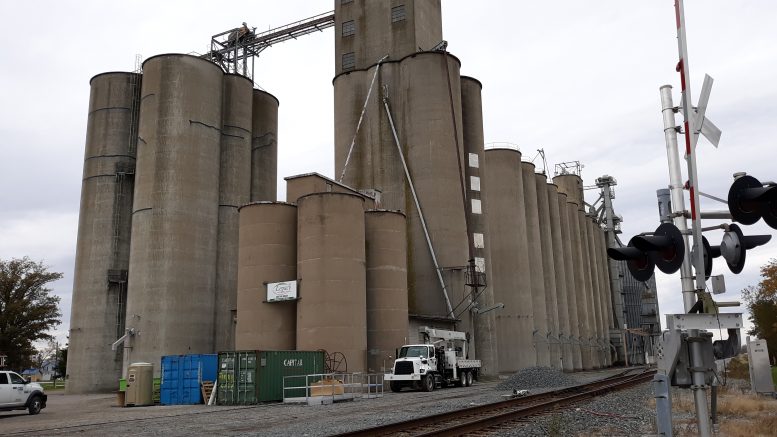By JAN LARSON McLAUGHLIN
BG Independent News
For the past two months, three corn silos at the Custar grain elevator have been smoldering – with one of the silo roofs being blown off by an explosion last month when fire crews tried to cool down the corn.
Mark Sunderman, CEO of Legacy Farmers Cooperative which operates the Custar elevator, said Monday that three of the 100-foot concrete silos are still smoldering. Legacy is working with a second contractor to empty the bins. The first contractor was not successful, Sunderman said.
“We’re working diligently to get the new crew in here as soon as they can,” Sunderman said.
Milton Township Fire District received the first call about the silo fires on Sept. 5 from the elevator. Since then, the smell of smoke is evident whichever way the wind blows from Custar.
The explosion occurred two weeks ago, when Milton Township Fire District was trying to cool down the smoldering corn inside. A fire crew was attempting to go in from the top with water – when the roof blew off before they even started, Milton Township Fire Chief Jay Carter said.
No one was injured, Carter said.
“It blew the roof off of the one,” the chief said. “Usually a secondary blast is a problem” with silo fires, but did not occur in this case, he said.
“We’re thankful there were no injuries,” Sunderman said.
Townspeople reported hearing the explosion, Carter said, but it wasn’t enough to draw everyone from their homes.
“It’s a concern,” the chief said. “It’s still smoldering. I hope that it’s resolved soon.”
In some cases of silo fires, manhole doors can be opened on the side, and the corn will flow out. But in this case, the corn is rotted, wet and clumped into big chunks.
The corn in the silos sat outside for a long period and was wet when it was placed inside, Sunderman said.
“There really isn’t a good reason to put wet corn in a bin except to run it through a dryer,” he said. But in this case, that process didn’t work.
Middleton Township Fire Chief Steve Asmus said spontaneous combustion sometimes occurs when bad grain is allowed to sit for periods. That is especially the case when corn is stored outside in a pile then moved into a bin.
“The grain spoils and it gets to a point it gets so hot, it starts smoldering,” said Asmus, who worked at The Andersons for 34 years, 20 years in plant protection. He has experienced some bin fires, and the Edwin grain elevator explosion in 2005 along the Maumee River in Toledo.
The only way to put out the fire is to empty the bins, so firefighters can get at the hot spots, Asmus said.
“If it’s deep-seated in the grain, you can’t see it from the top,” he said.
A concerned citizen from the Custar area notified the Wood County Emergency Management Agency about the ongoing fire on Oct. 23, according to EMA Director Jeff Klein.
Klein went out to the site to meet with Legacy officials and the contractor working to get the smoldering corn out of the silos. He could smell the smoke from the elevator at least a mile away.
“We know this is going on,” Klein said. “If you put wet corn away, it can spontaneously combust.”
The Wood County Sheriff’s Office has taken its drone to the elevator to get images from overhead.
“We know it’s definitely hot inside,” from the thermal images, Klein said.

